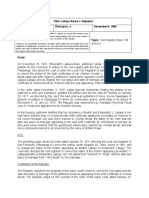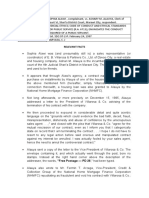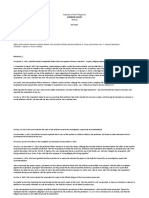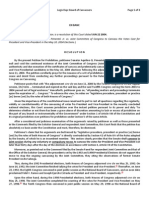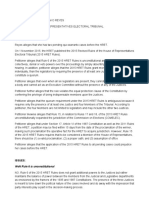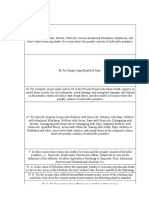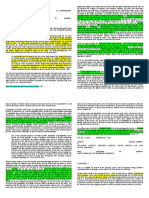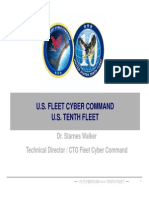0 ratings0% found this document useful (0 votes)
55 viewsRegina Ongsiako Reyes House of Representatives Electoral Tribunal
Regina Ongsiako Reyes House of Representatives Electoral Tribunal
Uploaded by
Nicole Ann Delos ReyesThe petitioner questions the constitutionality of several provisions of the 2015 HRET Rules. Specifically, the petitioner alleges that: 1) Rule 6, which requires the presence of at least one Supreme Court justice to constitute a quorum, grants unjust powers to the justices; 2) Rule 15, in conjunction with Rules 17-18, unconstitutionally expands the jurisdiction of COMELEC; and 3) the requisites to be considered a member of the House of Representatives under Rule 15 are invalid. However, the HRET maintains that its rules are constitutional and within its powers. Ultimately, the Court upholds the constitutionality of the challenged HRET rules.
Copyright:
© All Rights Reserved
Available Formats
Download as DOCX, PDF, TXT or read online from Scribd
Regina Ongsiako Reyes House of Representatives Electoral Tribunal
Regina Ongsiako Reyes House of Representatives Electoral Tribunal
Uploaded by
Nicole Ann Delos Reyes0 ratings0% found this document useful (0 votes)
55 views2 pagesThe petitioner questions the constitutionality of several provisions of the 2015 HRET Rules. Specifically, the petitioner alleges that: 1) Rule 6, which requires the presence of at least one Supreme Court justice to constitute a quorum, grants unjust powers to the justices; 2) Rule 15, in conjunction with Rules 17-18, unconstitutionally expands the jurisdiction of COMELEC; and 3) the requisites to be considered a member of the House of Representatives under Rule 15 are invalid. However, the HRET maintains that its rules are constitutional and within its powers. Ultimately, the Court upholds the constitutionality of the challenged HRET rules.
Original Title
67. Reyes v. HRET
Copyright
© © All Rights Reserved
Available Formats
DOCX, PDF, TXT or read online from Scribd
Share this document
Did you find this document useful?
Is this content inappropriate?
The petitioner questions the constitutionality of several provisions of the 2015 HRET Rules. Specifically, the petitioner alleges that: 1) Rule 6, which requires the presence of at least one Supreme Court justice to constitute a quorum, grants unjust powers to the justices; 2) Rule 15, in conjunction with Rules 17-18, unconstitutionally expands the jurisdiction of COMELEC; and 3) the requisites to be considered a member of the House of Representatives under Rule 15 are invalid. However, the HRET maintains that its rules are constitutional and within its powers. Ultimately, the Court upholds the constitutionality of the challenged HRET rules.
Copyright:
© All Rights Reserved
Available Formats
Download as DOCX, PDF, TXT or read online from Scribd
Download as docx, pdf, or txt
0 ratings0% found this document useful (0 votes)
55 views2 pagesRegina Ongsiako Reyes House of Representatives Electoral Tribunal
Regina Ongsiako Reyes House of Representatives Electoral Tribunal
Uploaded by
Nicole Ann Delos ReyesThe petitioner questions the constitutionality of several provisions of the 2015 HRET Rules. Specifically, the petitioner alleges that: 1) Rule 6, which requires the presence of at least one Supreme Court justice to constitute a quorum, grants unjust powers to the justices; 2) Rule 15, in conjunction with Rules 17-18, unconstitutionally expands the jurisdiction of COMELEC; and 3) the requisites to be considered a member of the House of Representatives under Rule 15 are invalid. However, the HRET maintains that its rules are constitutional and within its powers. Ultimately, the Court upholds the constitutionality of the challenged HRET rules.
Copyright:
© All Rights Reserved
Available Formats
Download as DOCX, PDF, TXT or read online from Scribd
Download as docx, pdf, or txt
You are on page 1of 2
1. Reyes v.
HRET (Delos Reyes)
October 16, 2018 | J. Carpio | Article VI, HRET Rules Petitioner alleges that under Section 17, Article VI of the 1987 Constitution as well as
the 2011 Rules of the HRET, a petition may be filed within 15 days from the date of
the proclamation of the winner, making such proclamation the operative fact for the
Petitioner: REGINA ONGSIAKO REYES HRET to acquire jurisdiction. However, Rule 15 of the 2015 HRET Rules requires
Respondents: HOUSE OF REPRESENTATIVES ELECTORAL TRIBUNAL that to be considered a Member of the House of Representatives, there should be:
(1) a valid proclamation;
SUMMARY: (2) a proper oath; and
Reyes questions the constitutionality of several provisions of the HRET Rules, (3) assumption of office.
namely: a. the rule which requires the presence of at least one Justice of the
Supreme Court to constitute a quorum; b. the rule on constitution of a quorum; and Further, Rule 17 of the 2015 HRET Rules states that election protests should be filed
c. the requisites to be considered a member of the House of Representatives. within 15 days from June 30 of the election year or the date of actual assumption of
office, whichever is later, while Rule 18 provides that petitions for quo warranto shall
be filed within 15 days from June 30 of the election year or the date of actual
DOCTRINE: assumption of office, whichever is later. Petitioner alleges that this would allow the
COMELEC to determine whether there was a valid proclamation or a proper oath, as
well as give it opportunity to entertain cases between the time of the election and
The presence of the three Justices in the HRET is meant to tone down the political June 30 of the election year or actual assumption of office, whichever is later.
nature of the cases involved and do away with the impression that party interests
play a part in the decision-making process. On the other hand, the HRET maintains that it has the power to promulgate its own
rules that would govern the proceedings before it. The HRET points out that under
Rule 6 of the 2015 HRET Rules, a quorum requires the presence of at least one
Justice-member and four members of the Tribunal. The HRET argues that the
FACTS: requirement rests on substantial distinction because there are only three Justice-
members of the Tribunal as against six Legislator-members. The HRET further
Petitioner alleges that Rule 6 of the 2015 HRET Rules is unconstitutional as it gives argues that the requirement of four members assures the presence of at least two
the Justices, collectively, denial or veto powers over the proceedings by simply Legislator-members to constitute a quorum. The HRET adds that the requirement of
absenting themselves from any hearing. the presence of at least one Justice was incorporated in the Rules to maintain
judicial equilibrium in deciding election contests and because the duty to decide
In addition, petitioner alleges that the 2015 HRET Rules grant more powers to the election cases is a judicial function. The HRET states that petitioner's allegation that
Justices, individually, than the legislators by requiring the presence of at least one Rule 6 of the 2015 HRET Rules gives the Justices virtual veto power to stop the
Justice in order to constitute a quorum. proceedings by simply absenting themselves is not only speculative but also imputes
bad faith on the part of the Justices. The HRET states that it only has jurisdiction
Petitioner alleges that even when all six legislators are present, they cannot over a member of the House of Representatives. In order to be considered a
constitute themselves as a body and cannot act as an Executive Committee without member of the House of Representatives, there must be a concurrence of the
the presence of any of the Justices. following requisites: (1) a valid proclamation; (2) a proper oath; and (3) assumption of
office. Hence, the requirement of concurrence of these three requisites is within the
Petitioner alleges that the quorum requirement under the 2015 HRET Rules is power of the HRET to make.
ambiguous because it requires only the presence of at least one Justice and four
Members of the Tribunal. ISSUE/S:
WON the 2015 HRET Rules is unconstitutional..
Petitioner likewise alleges that Rule 15, in relation to Rules 17 and 18, of the 2015
HRET Rules unconstitutionally expanded the jurisdiction of the Commission on RATIO:
Elections (COMELEC). NO.
As to presence of at least one Justice-member to Constitute a Quorum, Rule 6
of the 2015 HRET Rules does not grant additional powers to the Justices but rather
maintains the balance of power between the members from the Judicial and
Legislative departments as envisioned by the framers of the 1935 and 1987
Constitutions. The presence of the three Justices is meant to tone down the political
nature of the cases involved and do away with the impression that party interests
play a part in the decision-making process. Rule 6(a) of the 2015 HRET Rules
requires the presence of at least one Justice and four members of the Tribunal to
constitute a quorum. This means that even when all the Justices are present, at least
two members of the House of Representatives need to be present to constitute a
quorum. Without this rule, it would be possible for five members of the House of
Representatives to convene and have a quorum even when no Justice is present.
This would render ineffective the rationale contemplated by the framers of the 1935
and 1987 Constitutions for placing the Justices as members of the HRET. Rule 6(a)
of the 2015 HRET Rules does not make the Justices indispensable members to
constitute a quorum but ensures that representatives from both the Judicial and
Legislative departments are present to constitute a quorum. Members from both the
Judicial and Legislative departments become indispensable to constitute a quorum.
The last sentence of Section 17, Article VI of the 1987 Constitution also provides that
"[t]he senior Justice in the Electoral Tribunal shall be its Chairman." This means that
only a Justice can chair the Electoral Tribunal. As such, there should always be one
member of the Tribunal who is a Justice. If all three Justice-members inhibit
themselves in a case, the Supreme Court will designate another Justice to chair the
Electoral Tribunal in accordance with Section 17, Article VI of the 1987 Constitution.
As to the expanded jurisdiction of the Comelec, HRET's jurisdiction is provided
under Section 17, Article VI of the 1987 Constitution which states that "[t]he Senate
and the House of Representatives shall each have an Electoral Tribunal which shall
be the sole judge of all contests relating to the election, returns, and qualifications of
their respective Members." There is no room for the COMELEC to assume
jurisdiction because HRET's jurisdiction is constitutionally mandated.
You might also like
- Six Sigma ProjectDocument16 pagesSix Sigma ProjectArvin Dalisay100% (1)
- David VS MacapagalDocument12 pagesDavid VS Macapagalarden1imNo ratings yet
- Business Management Ethics 1Document29 pagesBusiness Management Ethics 1Christy Malabanan100% (1)
- Macalintal Vs PETDocument4 pagesMacalintal Vs PETMarkNo ratings yet
- Macalintal Vs PETDocument1 pageMacalintal Vs PETChloe HernaneNo ratings yet
- Vilando Vs HretDocument7 pagesVilando Vs HretIvan CubeloNo ratings yet
- Baguilat V Alvarez (G.R. No. 227757)Document3 pagesBaguilat V Alvarez (G.R. No. 227757)ellavisda100% (1)
- Ampatuan VS Puno DDocument3 pagesAmpatuan VS Puno DJanica AngelesNo ratings yet
- Ginsberg Vs New York Case DigestDocument2 pagesGinsberg Vs New York Case DigestEly SibayanNo ratings yet
- Civ Rev 1 Rowe Vs RepublicDocument2 pagesCiv Rev 1 Rowe Vs RepublicOM MolinsNo ratings yet
- GR No. 202242, Chavez v. JBC, July 17, 2012Document25 pagesGR No. 202242, Chavez v. JBC, July 17, 2012VERA FilesNo ratings yet
- 2 Lambino Vs ComelecDocument2 pages2 Lambino Vs ComelecApril Gem BalucanagNo ratings yet
- Daza V Singson DigestDocument2 pagesDaza V Singson DigestMarkNo ratings yet
- Bello V COMELECDocument5 pagesBello V COMELECsai_bautista_1No ratings yet
- Aklat v. ComelecDocument1 pageAklat v. ComelecRodeo Roy Seriña DagohoyNo ratings yet
- TAGOLINO vs. HRETDocument2 pagesTAGOLINO vs. HRET'mhariie-mhAriie TOotNo ratings yet
- GR No. 206666Document2 pagesGR No. 206666Juvial Guevarra BostonNo ratings yet
- (Digest) Alawi V AlauyaDocument4 pages(Digest) Alawi V AlauyaWilma CruzNo ratings yet
- 9 Scra 230 Gonzales V HechanovaDocument4 pages9 Scra 230 Gonzales V Hechanovacmdgrp_pro2No ratings yet
- 05 Abayon V ComelecDocument4 pages05 Abayon V ComelecYPENo ratings yet
- Espina vs. Zamora G.R. No 143855Document5 pagesEspina vs. Zamora G.R. No 143855ChristianneDominiqueGravoso100% (1)
- Republic Vs CA - JanexDocument1 pageRepublic Vs CA - JanexLord AumarNo ratings yet
- Separate Opinions (Imbong Vs Ochoa) - LeonenDocument2 pagesSeparate Opinions (Imbong Vs Ochoa) - LeonenErwinRommelC.FuentesNo ratings yet
- Lopez vs. Comelec and Tessie P. Villanueva, G.R. No. 182701, July 23, 2008Document4 pagesLopez vs. Comelec and Tessie P. Villanueva, G.R. No. 182701, July 23, 2008Michelle Catadman100% (1)
- Dual Citizenship or Dual Allegiance (Cordora vs. COMELEC, Et Al. (G.R. No. 176947, 19 February 2009) )Document2 pagesDual Citizenship or Dual Allegiance (Cordora vs. COMELEC, Et Al. (G.R. No. 176947, 19 February 2009) )RR FNo ratings yet
- Funa v. Agra DigestDocument7 pagesFuna v. Agra DigestJune Vincent FerrerNo ratings yet
- 0140 Public Interest Center V Elma PDFDocument3 pages0140 Public Interest Center V Elma PDFXyra BaldiviaNo ratings yet
- Banda DigestDocument1 pageBanda DigestEAP11705790No ratings yet
- Trillanes v. Hon. Castillo-Marigomen, 2018Document19 pagesTrillanes v. Hon. Castillo-Marigomen, 2018Julius AubertNo ratings yet
- Mariano vs. ComelecDocument1 pageMariano vs. ComelecAnsis Villalon PornillosNo ratings yet
- Felix G. Valenzona, Petitioner, vs. The People of The PhilippinesDocument13 pagesFelix G. Valenzona, Petitioner, vs. The People of The PhilippinesGuang Xi ZheNo ratings yet
- Gudani v. SengaDocument2 pagesGudani v. SenganrpostreNo ratings yet
- Mortel Vs AspirasDocument4 pagesMortel Vs AspirasLAW10101No ratings yet
- ACT Teachers Vs Duterte (Full Case)Document1 pageACT Teachers Vs Duterte (Full Case)prince pacasumNo ratings yet
- Adm 8108 10299Document11 pagesAdm 8108 10299Juan Carlo CastanedaNo ratings yet
- R.A. 7941Document3 pagesR.A. 7941Stephen Jasper SamsonNo ratings yet
- B. I. 1. Cruz vs. Mina, 522 SCRA 387Document4 pagesB. I. 1. Cruz vs. Mina, 522 SCRA 387Marienyl Joan Lopez VergaraNo ratings yet
- Eastern Shipping Lines vs. POEA, 166 SCRA 533, G.R. No. L-76633, October 18, 1988Document11 pagesEastern Shipping Lines vs. POEA, 166 SCRA 533, G.R. No. L-76633, October 18, 1988JemNo ratings yet
- Rufino Vs EndrigaDocument10 pagesRufino Vs EndrigaDumaganNo ratings yet
- Bagong Bayani VS, Comelec Legislative DepartmentDocument2 pagesBagong Bayani VS, Comelec Legislative DepartmentPatricia Denise Emilio-Del PilarNo ratings yet
- Cayetano vs. Monsod G.R. No. 100113 September 3, 1991Document45 pagesCayetano vs. Monsod G.R. No. 100113 September 3, 1991Mark Catabijan CarriedoNo ratings yet
- Javellana Vs Executive SecretaryDocument5 pagesJavellana Vs Executive SecretaryAngela Marie AlmalbisNo ratings yet
- DUNCANO V SANDIGANBAYAN G.R. No. 191894Document3 pagesDUNCANO V SANDIGANBAYAN G.R. No. 191894Ariza ValenciaNo ratings yet
- The Legislative DepartmentDocument13 pagesThe Legislative DepartmentCarlemae SanquinaNo ratings yet
- 4 Insular Lumber Company V CA and BIRDocument1 page4 Insular Lumber Company V CA and BIRFloriv VillalobosNo ratings yet
- (Case No. 336) : Prepared By: Cecille Diane DJ. MangaserDocument2 pages(Case No. 336) : Prepared By: Cecille Diane DJ. MangaserCecille MangaserNo ratings yet
- Casco Vs GimenezDocument2 pagesCasco Vs GimenezMemings EvilshitNo ratings yet
- Aguinaldo vs. Aquino (G.R. No. 224302 - November 29, 2016)Document42 pagesAguinaldo vs. Aquino (G.R. No. 224302 - November 29, 2016)Lecdiee Nhojiezz Tacissea SalnackyiNo ratings yet
- ACCFA v. CUGCODocument6 pagesACCFA v. CUGCOJude FanilaNo ratings yet
- Republic V Sandiganbayan G.R. No. 90478 CASE DIGESTDocument2 pagesRepublic V Sandiganbayan G.R. No. 90478 CASE DIGESTLBitzNo ratings yet
- Vallenzuela VS VallartaDocument2 pagesVallenzuela VS VallartaMA. TERESA DADIVASNo ratings yet
- Federation of Free Farmers V CA, G.R. NO. 41161, 1981Document67 pagesFederation of Free Farmers V CA, G.R. NO. 41161, 1981Grester FernandezNo ratings yet
- Pimentel V Joint ComDocument3 pagesPimentel V Joint ComDorothy PuguonNo ratings yet
- Lopez V Comelec GR 182701 DigestDocument4 pagesLopez V Comelec GR 182701 DigestjohnmiggyNo ratings yet
- Dimaporo v. MitraDocument2 pagesDimaporo v. Mitraalexis_beaNo ratings yet
- Notes, If Any: Notes Lang No Need To WriteDocument2 pagesNotes, If Any: Notes Lang No Need To WriteChristina AureNo ratings yet
- United BF Homeowner's Association vs. BF Homes, Inc.Document7 pagesUnited BF Homeowner's Association vs. BF Homes, Inc.jodelle11100% (1)
- Reyes vs. HRETDocument3 pagesReyes vs. HRETAgnes LintaoNo ratings yet
- Reyes v. HRET G.R. No. 221103, October 16, 2018 Carpio, J. FactsDocument2 pagesReyes v. HRET G.R. No. 221103, October 16, 2018 Carpio, J. FactsAntonio Bartolome100% (1)
- ONGSIAKO - REYES v. HRETDocument2 pagesONGSIAKO - REYES v. HRETMMAC100% (1)
- Reyes Vs HRET DigestDocument3 pagesReyes Vs HRET DigestJan Michael Jay CuevasNo ratings yet
- Reyes v. HRETDocument32 pagesReyes v. HRETcitizenNo ratings yet
- I. For Those Crimes Like, Murder, Parricide, Serious Intentional Mutilation, Infanticide, andDocument6 pagesI. For Those Crimes Like, Murder, Parricide, Serious Intentional Mutilation, Infanticide, andNicole Ann Delos ReyesNo ratings yet
- Tax 5 22Document141 pagesTax 5 22Nicole Ann Delos ReyesNo ratings yet
- Evid 13Document44 pagesEvid 13Nicole Ann Delos ReyesNo ratings yet
- G.R. No. 197818 February 25, 2015 People OF THE PIDLIPPINES, Plaintiff-Appellee, ALLAN DIAZ y ROXAS, Accused-AppellantDocument16 pagesG.R. No. 197818 February 25, 2015 People OF THE PIDLIPPINES, Plaintiff-Appellee, ALLAN DIAZ y ROXAS, Accused-AppellantNicole Ann Delos ReyesNo ratings yet
- G.R. No. 200877 November 12, 2014 People OF THE PHILIPPINES, Plaintiff-Appellee, CHARVE JOHN LAGAHIT, Accused-AppellantDocument31 pagesG.R. No. 200877 November 12, 2014 People OF THE PHILIPPINES, Plaintiff-Appellee, CHARVE JOHN LAGAHIT, Accused-AppellantNicole Ann Delos ReyesNo ratings yet
- Ang Nars Party List V. Executive Secretary (Delos Reyes)Document2 pagesAng Nars Party List V. Executive Secretary (Delos Reyes)Nicole Ann Delos ReyesNo ratings yet
- G.R. No. 198627 DST Movers CORPORATION, Petitioner, People'S General Insurance Corporation, RespondentDocument37 pagesG.R. No. 198627 DST Movers CORPORATION, Petitioner, People'S General Insurance Corporation, RespondentNicole Ann Delos ReyesNo ratings yet
- Specpro 2Document31 pagesSpecpro 2Nicole Ann Delos ReyesNo ratings yet
- G.R. No. 182648 June 17, 2015 Herman MEDINA, Petitioner, People of The Philippines, RespondentDocument28 pagesG.R. No. 182648 June 17, 2015 Herman MEDINA, Petitioner, People of The Philippines, RespondentNicole Ann Delos ReyesNo ratings yet
- G.R. No. 181539 July 24, 2013 People OF THE PHILIPPINES, Plaintiff-Appellee, EDWIN ALEMAN y LONGHAS, Accused-AppellantDocument27 pagesG.R. No. 181539 July 24, 2013 People OF THE PHILIPPINES, Plaintiff-Appellee, EDWIN ALEMAN y LONGHAS, Accused-AppellantNicole Ann Delos ReyesNo ratings yet
- Conflict 8Document42 pagesConflict 8Nicole Ann Delos ReyesNo ratings yet
- Conflict 5 - AddDocument22 pagesConflict 5 - AddNicole Ann Delos ReyesNo ratings yet
- Insurance 9Document25 pagesInsurance 9Nicole Ann Delos ReyesNo ratings yet
- G.R. No.190486 November 26, 2014 Stanley Fine Furniture, Elenaand Carlos Wang, Petitioners, Victor T. Gallano and Enriquito Siarez, RespondentsDocument66 pagesG.R. No.190486 November 26, 2014 Stanley Fine Furniture, Elenaand Carlos Wang, Petitioners, Victor T. Gallano and Enriquito Siarez, RespondentsNicole Ann Delos ReyesNo ratings yet
- Conflict 5Document4 pagesConflict 5Nicole Ann Delos ReyesNo ratings yet
- G.R. No. 156087 May 8, 2009 Kuwait Airways, CORPORATION, Petitioner, PHILIPPINE AIRLINES, INC., RespondentDocument27 pagesG.R. No. 156087 May 8, 2009 Kuwait Airways, CORPORATION, Petitioner, PHILIPPINE AIRLINES, INC., RespondentNicole Ann Delos ReyesNo ratings yet
- Extrajudicial Settlement of EstateDocument3 pagesExtrajudicial Settlement of EstateNicole Ann Delos ReyesNo ratings yet
- Insurance 10Document21 pagesInsurance 10Nicole Ann Delos ReyesNo ratings yet
- Gesolgon, Matti and Custodio For Appellees. Aguedo Y. Jepte in His Own BehalfDocument42 pagesGesolgon, Matti and Custodio For Appellees. Aguedo Y. Jepte in His Own BehalfNicole Ann Delos ReyesNo ratings yet
- Guerrero & Torres For Petitioner. Jose B. Layug For Private RespondentsDocument8 pagesGuerrero & Torres For Petitioner. Jose B. Layug For Private RespondentsNicole Ann Delos ReyesNo ratings yet
- Week 2Document53 pagesWeek 2Nicole Ann Delos ReyesNo ratings yet
- G.R. No. 168115 June 8, 2007 VICENTE ONG LIM SING, JR., Petitioner, vs. Feb Leasing & Finance Corporation, RespondentDocument41 pagesG.R. No. 168115 June 8, 2007 VICENTE ONG LIM SING, JR., Petitioner, vs. Feb Leasing & Finance Corporation, RespondentNicole Ann Delos ReyesNo ratings yet
- Lesson Plan 12-1 - Lindsey GarberDocument3 pagesLesson Plan 12-1 - Lindsey Garberapi-662060477No ratings yet
- 138 - 1974 - Muslim LawDocument13 pages138 - 1974 - Muslim LawAditya MaheshwariNo ratings yet
- Comp1 Unit1 DiscussDocument4 pagesComp1 Unit1 DiscussP D SpencerNo ratings yet
- A Gentleman's Guide To Love & Murder!Document9 pagesA Gentleman's Guide To Love & Murder!Juan Ignacio HervasNo ratings yet
- Blunt Adominal TraumaDocument14 pagesBlunt Adominal TraumaMuhammad Bima AkbarNo ratings yet
- Telephone TrainingDocument29 pagesTelephone Trainingeric_mdisNo ratings yet
- Instapdf - in Full Body Test Checkup List 707Document6 pagesInstapdf - in Full Body Test Checkup List 707tgkoyyhkkglhNo ratings yet
- Life Power LyricDocument1 pageLife Power Lyriclovea6793No ratings yet
- Brand Valuation 1Document10 pagesBrand Valuation 1Amanda MeitaNo ratings yet
- Comprehensiveproblemset#8Document15 pagesComprehensiveproblemset#8DEO100% (1)
- International Journal of Forecasting: Nassim Nicholas Taleb, Yaneer Bar-Yam, Pasquale CirilloDocument10 pagesInternational Journal of Forecasting: Nassim Nicholas Taleb, Yaneer Bar-Yam, Pasquale CirilloStewart HendersonNo ratings yet
- Audioscript Level 3Document4 pagesAudioscript Level 3Indiana SaavedraNo ratings yet
- Lifting The Corporate VeilDocument21 pagesLifting The Corporate VeilPrakhar BhandariNo ratings yet
- Applications of Derivatives (Extreme Values of Functions)Document9 pagesApplications of Derivatives (Extreme Values of Functions)Abdul Halil AbdullahNo ratings yet
- Grade 4 Week 2 Lesson 2 UpdatedDocument10 pagesGrade 4 Week 2 Lesson 2 Updatedairah jane jocsonNo ratings yet
- FTPDocument3 pagesFTPDani SupriyadiNo ratings yet
- ArchitecturaldigestDocument2 pagesArchitecturaldigestSimone NeivaNo ratings yet
- US Fleet Cyber Command, US Tenth FleetDocument27 pagesUS Fleet Cyber Command, US Tenth FleetTerminal XNo ratings yet
- Bristlecon E: AboutDocument12 pagesBristlecon E: AboutDiksha KamraNo ratings yet
- Kinship TypesDocument14 pagesKinship Typeskrishnasharma1476No ratings yet
- Labour Law I First Draft - Mass MaharajDocument3 pagesLabour Law I First Draft - Mass MaharajprawinwaveNo ratings yet
- No Words & Meaning Sentences: Written By:Nigah Hussain M.SC Physics:0349-7987024Document6 pagesNo Words & Meaning Sentences: Written By:Nigah Hussain M.SC Physics:0349-7987024Zawar HussainNo ratings yet
- Elizabeth Lopez Introduction To Special Education 203 I.E.P Document Saturday December 5, 2020Document5 pagesElizabeth Lopez Introduction To Special Education 203 I.E.P Document Saturday December 5, 2020api-533372980No ratings yet
- 2023 MPSM KELANTAN With AnswersDocument23 pages2023 MPSM KELANTAN With AnswersrossypissyNo ratings yet
- Buddha Bh2 Ita3 Samanta Jvala M2l2 Vi0uddhe Sphurita Cint2ma5i Mudra H4daya Apar2jita Dh2ra51 Prati-Sar2 Mah2 Vidy2 R2ja.Document7 pagesBuddha Bh2 Ita3 Samanta Jvala M2l2 Vi0uddhe Sphurita Cint2ma5i Mudra H4daya Apar2jita Dh2ra51 Prati-Sar2 Mah2 Vidy2 R2ja.d4129889No ratings yet
- SS and SSS Chap 1 To 10 (2020)Document215 pagesSS and SSS Chap 1 To 10 (2020)Dinh TranNo ratings yet
- A Grammar of Mëranaw LanguageDocument8 pagesA Grammar of Mëranaw LanguageInternational Journal of Innovative Science and Research Technology100% (1)
- Context CluesDocument6 pagesContext CluesSaymon Casilang SarmientoNo ratings yet









